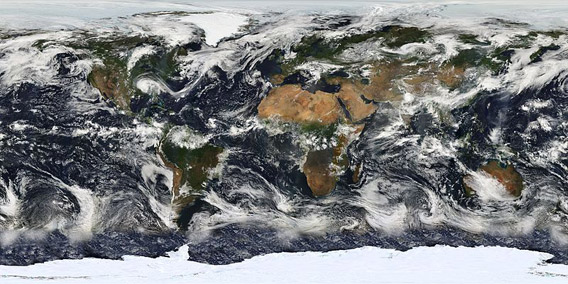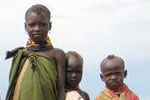
Observations of planet Earth from the Moderate Resolution Imaging Spectroradiometer (MODIS) on July 11, 2005. Photo by: NASA.
Seventeen top scientists and four acclaimed conservation organizations have called for radical action to create a better world for this and future generations. Compiled by 21 past winners of the prestigious Blue Planet Prize, a new paper recommends solutions for some of the world’s most pressing problems including climate change, poverty, and mass extinction. The paper, entitled Environment and Development Challenges: The Imperative to Act, was recently presented at the UN Environment Program governing council meeting in Nairobi, Kenya.
The Blue Planet Prize is given for “outstanding achievements in scientific research and its application that have helped provide solutions to global environmental problems.” Dubbed by some as the Nobel Prize for the environment, award winners have included such luminaries as environmentalist James Lovelock, biologist Paul Ehrlich, physicist Amory Lovins, economist Nicholas Stern, and climatologist James Hansen, all of whom have contributed to the report.
“The current system is broken,” said climatologist Bob Watson, a Blue Planet winner in 2010 and the instigator of the report. “It is driving humanity to a future that is 3-5 degrees Celsius warmer than our species has ever known, and is eliminating the ecology that we depend on for our health, wealth and senses of self. We cannot assume that technological fixes will come fast enough. Instead we need human solutions. The good news is that they exist but decision makers must be bold and forward thinking to seize them.”
 Boys in the Republic of the Congo. Photo by: Nancy Butler. |
The ambitious paper arrives only a few months before “Rio+20 Conference: The Future We Want,” a global environmental meeting 20 years after the notable Rio Summit. However, expectations for real action at the Rio+20 summit have been dampened by the release of a draft agreement that lacks teeth and, according to critics, allows nations to once again make vague pledges that forestall actual action.
For their part, the Blue Planet laureates call on the world to rapidly reduce greenhouse gas emissions, switch out GDP (gross domestic product) for a more holistic measure of national well-being, decouple environmental destruction from consumption, drop subsidies for fossil fuels and environmentally destructive agricultural practices, put a market value on biodiversity and ecosystem services, work with grassroots movements to create bottom-up action, and finally address overpopulation.
“If we are to achieve our dream, the time to act is now, given the inertia in the socio-economic system, and that the adverse effects of climate change and loss of biodiversity cannot be reversed for centuries or are irreversible,” the authors write.
Declaring that “the system is broken and our current pathway will not realize [the dream of a better world]” the authors point out that “civilization is faced with a perfect storm of problems driven by overpopulation, overconsumption by the rich, the use of environmentally malign technologies, and gross inequalities.” Worsening the situation, according to the scientists and environmentalists, is the dangerous “myth” that “physical economies can grow forever.”
A new economy for a new millennium
The current global economy must be re-fashioned from a growth model to a sustainable one that takes nature into account, argue the scientists.
“Since most goods and services sold today fail to bear the full environmental and social costs of production and consumption, we need to reach consensus on methodologies to price them properly,” the scientists write.
Many of the world’s natural resources are finite (minerals, fossil fuels, and water) and those that are renewable (forests, fish, and food) are easily exhausted when mismanaged and can even be destroyed entirely. Given this, according to the report, economists need to re-define the capital in question to reflect those that are nature-based and those that are human-based.
“Governments should recognize the serious limitations of GDP as a measure of economic activity and complement it with measures of the five forms of capital, built, financial, natural, human and social capital, i.e., a measure of wealth that integrates economic, environmental and social dimensions,” the paper argues. The scientists admit that the transition will prove difficult, but it is necessary.
 Girl in Egypt. Photo by: Rhett A. Butler. |
“There is an urgent need to break the link between production and consumption on the one hand and environmental destruction on the other. This can allow risking material living standards for a period that would allow us to overcome world poverty. Indefinite material growth on a planet with finite and often fragile natural resources will however, eventually be unsustainable,” they write.
Still, while such action may require phasing out certain industries and economic practices, other green industries could fill in the gaps, providing jobs and stability.
“Costing environmental externalities could open new opportunities for green growth and green jobs,” the researchers write, adding that “efficient resource use (e.g., energy or water) saves money for businesses and households. Valuing and creating markets for ecosystem services can provide new economic opportunities. A green economy will be a source of future employment and innovation.”
What’s standing in the way of such a transition? The report warns that the current alliances between governments and big corporations is undermining the ability of society to change business-as-usual practices.
“The international nature of much of the corporate sector involved in natural resource use means that even the governments of the countries in which they are headquartered have limited ability to influence their actions and decisions,” they write, adding that the on-going dependence on fossil fuels “underlies many of the problems we face today.”
To succeed, government must be transformed at all levels, the researchers contend.
“At the local level public hearings and social audits can bring the voices of marginalized groups into the forefront. At national level, parliamentary and press oversight are key. Globally, we must find better means to agree and implement measures to achieve collective goals.”
But while all stakeholders must be involved, the scientists argue that grassroots movements, bottom-up activism, and local programs should be given more clout.
“There is a need to scale-up the grass roots actions by bringing together a complementary top-down and bottom-up approach to addressing these issues.”
The climate crisis
In order to tackle global climate change, the paper recommends a dual strategy of drastically increasing energy-efficiency while deploying renewable energy and carbon capture on a massive scale.
“Generally, developing countries located in the tropical areas of the world can benefit most from solar energy technologies […] In industrialized countries with very high energy consumption per capita, energy efficiency measures can be very effective,” the authors write adding that in developing countries, “economic progress can be achieved by adopting early in their growth trajectory energy efficient technologies rather than adopting obsolete technologies that will generate problems that will have to be fixed later.”
They note that clean energy could provide 75 percent of power in many parts of the world, and 90 percent in the tropics, by 2050.
“The main task is to scale-up, reduce costs and integrate renewables in future energy systems. Carefully developed, renewable energies can provide multiple benefits, including employment, energy security, human health, environment, and mitigation of climate change,” the paper reads.
 Dani child on his mother’s shoulder in Indonesian New Guinea. Photo by: Rhett A. Butler. |
As for carbon capture and storage, the authors still hold out hope despite a number of difficulties: “the main task is to reduce costs and achieve rapid technology improvement,” adding that, “a number of pilot projects around the world will, we hope, soon demonstrate their viability.”
While the scientists acknowledge that adaptation to climate change impacts is a necessity, they write that “the most effective adaptation strategy is mitigation in order to limit the magnitude of climate change.”
Interestingly, the researchers note that one can be a self-subscribed climate change denialist and still see the major benefits of clean energy.
“A transition to a low-carbon economy makes sense and makes money for many other compelling reasons [beyond mitigating climate change]. China, for example, is leading the global efficiency and clean-energy revolutions not because of international treaties and Conventions but to speed her own development and to improve public health and national security,” the authors write.
Life on Earth
Cutting greenhouse gas emissions rapidly is the overall solution to climate change, but saving life on Earth from extinction is less clear-cut.
“Biodiversity—the variety of genes, populations, species, communities, ecosystems, and ecological processes that make up life on Earth—underpins ecosystem services, sustains humanity, is foundational to the resilience of life on Earth, and is integral to the fabric of all the world’s cultures,” the paper’s authors write. Biodiversity and ecosystem services also underpin the global economy, they note, though this has been almost wholly neglected by our current economic model.
“The benefits that ecosystems contribute to human well-being have historically been provided free of charge, and demand for them is increasing. Although the global economic value of ecosystem services may be difficult to measure, it almost certainly rivals or exceeds aggregate global gross domestic product, and ecosystem benefits frequently outweigh costs of their conservation,” write the scientists.
They suggest a rapid move from “the resource exploitative method of conventional development to resource enrichment method of sustainable development” in the developing world. Currently, development in poorer countries usually implies large-scale industrial projects with massive environmental footprints: mining, logging, dams, fossil fuel exploitation, highway building etc.
“The value of ecosystem services and natural capital must be incorporated into national accounting and decision-making processes across all sectors of society, access to ecosystem benefits and costs of ecosystem conservation must be shared equitably, and biodiversity and ecosystem services must be seen as the most fundamental component of green economic development,” the scientists write.
 Boy in mokoro boat in Botswana. Photo by: Tiffany Roufs. |
According to the paper, loss of ecosystem services will soon hit the global economy to the tune of $500 billion every year. Given this, the scientists call for all countries to adopt a “national inclusive wealth accounting system, including accounting for ecosystem services imported and exported, which could stimulate further approaches to ecosystem service marketplace development.”
The authors also note that winning the battles on climate change and mass extinction aren’t mutually exclusive, because what aids biodiversity will often mitigate global warming, and vice-versa. For example, the scientists throw their support behind the REDD+ (Reducing Emissions from Deforestation and forest Degradation) program, which proposes to pay tropical nations to keep their forests standing.
Another issue that underlies the rest is overpopulation. The dramatic explosion of population over the past century has put increased strain on biodiversity, natural resources, food production, and the climate. Targeting overpopulation through non-draconian or compulsory means could provide a multitude of societal benefits in addition to lessening our overall environmental toll.
“The population issue should be urgently addressed by education and empowerment of women, including in the work-force and in rights, ownership and inheritance; health care of children and the elderly; and making modern contraception accessible to all,” the scientists write.
The Blue Planet awardees argue that nations must stop seeing environmental issues as disconnected, stand-alone problems since, for example, protecting ecosystems, such as forests, will mitigate climate changes, lessen the difficult of climate adaptation, and preserve biodiversity, amid a host of other benefits.
“A comprehensive, integrated ecosystem approach is a powerful ‘tool’ for identifying, analyzing and resolving complicated environmental problems, rather than the piecemeal approaches to multifaceted environmental problems that don’t work,” the researchers conclude.
A better world
The report doesn’t sugarcoat the scale of the problems facing societies today nor the heavy-lifting it will take to transform the global economy, however they say the future will be far worse if action is not taken quickly and decisively.
 Girl in Madagascar. Photo by: Rhett A. Butler. |
“In the face of an absolutely unprecedented emergency, society has no choice but to take dramatic action to avert a collapse of civilization,” the scientists write. “Either we will change our ways and build an entirely new kind of global society, or they will be changed for us.”
At the end of the tunnel, however, is a better world.
“We have a dream—a world without poverty—a world that is equitable—a world that respects human rights—a world with increased and improved ethical behavior regarding poverty and natural resources—a world that is environmentally, socially and economically sustainable, where the challenges such as climate change, loss of biodiversity and social inequity have been successfully addressed.”
Related articles
David vs. Goliath: Goldman Environmental Prize winners highlight development projects gone awry

(04/16/2012) A controversial dam, a massive mine, poisonous pesticides, a devastating road, and criminal polluters: many of this year’s Goldman Environmental Prize winners point to the dangers of poorly-planned, and ultimately destructive, development initiatives. The annual prize, which has been dubbed the Green Nobel Prize is awarded to six grassroots environmental heroes from around the world and includes a financial award of $150,000 for each winner.
Degraded lands hold promise in feeding 9 billion, while preserving forests
(03/29/2012) Making productive use of degraded lands and boosting productivity of small-holder farmers are key to meeting surging global consumption of agricultural products while preserving critical wildlife habitats, said an agricultural expert on the sidelines of the Skoll World Forum for Social Entrepreneurship in Oxford.
Six nations, including U.S., set up climate initiative to target short-term greenhouse gases
(02/20/2012) With global negotiations to tackle carbon emissions progressing interminably, nations are seeking roundabout ways to combat global climate change. U.S. Secretary of State, Hillary Clinton, announced in India last week a new six nation initiative to target non-carbon greenhouse gases, including soot (also known as “black carbon”), methane, and hydro-fluorocarbons (HFCs). Reductions of these emissions would not only impact short-term climate change, but also improve health and agriculture worldwide according to a recent study in Science.
New meteorological theory argues that the world’s forests are rainmakers

(02/01/2012) New, radical theories in science often take time to be accepted, especially those that directly challenge longstanding ideas, contemporary policy or cultural norms. The fact that the Earth revolves around the sun, and not vice-versa, took centuries to gain widespread scientific and public acceptance. While Darwin’s theory of evolution was quickly grasped by biologists, portions of the public today, especially in places like the U.S., still disbelieve. Currently, the near total consensus by climatologists that human activities are warming the Earth continues to be challenged by outsiders. Whether or not the biotic pump theory will one day fall into this grouping remains to be seen. First published in 2007 by two Russian physicists, Victor Gorshkov and Anastassia Makarieva, the still little-known biotic pump theory postulates that forests are the driving force behind precipitation over land masses.
Ecuador makes $116 million to not drill for oil in Amazon

(01/02/2012) A possibly ground-breaking idea has been kept on life support after Ecuador revealed its Yasuni-ITT Initiative had raked in $116 million before the end of the year, breaking the $100 million mark that Ecuador said it needed to keep the program alive. Ecuador is proposing to not drill for an estimated 850 million barrels of oil in the Ishpingo-Tambococha-Tiputinin (ITT) blocs of Yasuni National Park if the international community pledges $3.6 billion to a United Nations Development Fund (UNDF), or about half of what the oil is currently worth. The Yasuni-ITT Initiative would preserve arguably the most biodiverse region on Earth from oil exploitation, safeguard indigenous populations, and keep an estimated 410 million tons of CO2 out of the atmosphere. However, the initiative is not without its detractors, some arguing the program is little more than blackmail; meanwhile proponents say it could prove an effective way to combat climate change, deforestation, and mass extinction.
REDD advances—slowly—in Durban

(12/15/2011) A program proposed to reduce greenhouse gas emissions from deforestation and degradation made mixed progress during climate talks in Durban. Significant questions remain about financing and safeguards to protect against abuse, say forestry experts. REDD+ aims to reduce deforestation, forest degradation, and peatland destruction in tropical countries. Here, emissions from land use often exceed emissions from transportation and electricity generation. Under the program, industrialized nations would fund conservation projects and improved forest management. While REDD+ offers the potential to simultaneously reduce emissions, conserve biodiversity, maintain other ecosystem services, and help alleviate rural poverty, concerns over potential adverse impacts have plagued the program since its conception.
11 challenges facing 7 billion super-consumers

(10/31/2011) Perhaps the most disconcerting thing about Halloween this year is not the ghouls and goblins taking to the streets, but a baby born somewhere in the world. It’s not the baby’s or the parent’s fault, of course, but this child will become a part of an artificial, but still important, milestone: according to the UN, the Earth’s seventh billionth person will be born today. That’s seven billion people who require, in the very least, freshwater, food, shelter, medicine, and education. In some parts of the world, they will also have a car, an iPod, a suburban house and yard, pets, computers, a lawn-mower, a microwave, and perhaps a swimming pool. Though rarely addressed directly in policy (and more often than not avoided in polite conversations), the issue of overpopulation is central to environmentally sustainability and human welfare.
Five ways to feed billions without trashing the planet

(10/13/2011) At the end of this month the UN predicts global population will hit 7 billion people, having doubled from 3.5 billion in less than 50 years. Yet even as the Earth hits this new milestone, one billion people do not have enough food; meanwhile the rapid expansion of agriculture is one of the leading causes of global environmental degradation, including greenhouse gas emissions, destruction of forests, marine pollution, mass extinction, water scarcity, and soil degradation. So, how do we feed the human population—which continues to rise and is expected to hit nine billion by 2050—while preserving the multitude of ecosystem services that support global food production? A new study in Nature proposes a five-point plan to this dilemma.
Protected areas not enough to save life on Earth

(08/03/2011) Since the creation of Yellowstone National Park in 1872 protected areas have spread across the world. Today, over 100,000 protected areas—national parks, wildlife refuges, game reserves, marine protected areas (MPAs), wildlife sanctuaries, etc.—cover some 7.3 million square miles (19 million kilometers), mostly on land, though conservation areas in the oceans are spreading. While there are a number of reasons behind the establishment of protected areas, one of the most important is the conservation of wildlife for future generations. But now a new open access study in Marine Ecology Progress Series has found that protected areas are not enough to stem the loss of global biodiversity. Even with the volume of protected areas, many scientists say we are in the midst of a mass extinction with extinction levels jumping to 100 to 10,000 times the average rate over the past 500 million years. While protected areas are important, the study argues that society must deal with the underlying problems of human population and overconsumption if we are to have any chance of preserving life on Earth—and leaving a recognizable planet for our children.
Adaptation, justice and morality in a warming world

(07/28/2011) If last year was the first in which climate change impacts became apparent worldwide—unprecedented drought and fires in Russia, megaflood in Pakistan, record drought in the Amazon, deadly floods in South America, plus record highs all over the place—this may be the year in which the American public sees climate change as no longer distant and abstract, but happening at home. With burning across the southwest, record drought in Texas, majors flooding in the Midwest, heatwaves everywhere, its becoming harder and harder to ignore the obvious. Climate change consultant and blogger, Brian Thomas, says these patterns are pushing ‘prominent scientists’ to state ‘more explicitly that the pattern we’re seeing today shows a definite climate change link,’ but that it may not yet change the public perception in the US.
What does Nature give us? A special Earth Day article

(04/22/2011) There is no question that Earth has been a giving planet. Everything humans have needed to survive, and thrive, was provided by the natural world around us: food, water, medicine, materials for shelter, and even natural cycles such as climate and nutrients. Scientists have come to term such gifts ‘ecosystem services’, however the recognition of such services goes back thousands of years, and perhaps even farther if one accepts the caves paintings at Lascaux as evidence. Yet we have so disconnected ourselves from the natural world that it is easy—and often convenient—to forget that nature remains as giving as ever, even as it vanishes bit-by-bit. The rise of technology and industry may have distanced us superficially from nature, but it has not changed our reliance on the natural world: most of what we use and consume on a daily basis remains the product of multitudes of interactions within nature, and many of those interactions are imperiled. Beyond such physical goods, the natural world provides less tangible, but just as important, gifts in terms of beauty, art, and spirituality.
The ocean crisis: hope in troubled waters, an interview with Carl Safina

(02/07/2011) Being compared—by more than one reviewer—to Henry Thoreau and Rachel Carson would make any nature writer’s day. But add in effusive reviews that compare one to a jazz musician, Ernest Hemingway, and Charles Darwin, and you have a sense of the praise heaped on Carl Safina for his newest work, The View from Lazy Point: A Natural Year in an Unnatural World. Like Safina’s other books, The View from Lazy Point focuses on the beauty, poetry, and crisis of the world’s oceans and its hundreds-of-thousands of unique inhabitants. Taking the reader on a journey around the world—the Arctic, Antarctic, and the tropics—Safina always returns home to take in the view, and write about the wildlife of his home, i.e. Lazy Point, on Long Island. While Safina’s newest book addresses the many ways in which the ocean is being degraded, depleted, and ultimately imperiled as a living ecosystem (such as overfishing and climate change) it also tweezes out stories of hope by focusing on how single animals survive, and in turn how nature survives in an increasingly human world. However, what makes Safina’s work different than most nature writing is his ability to move seamlessly from contemporary practical problems to the age-old philosophical underpinnings that got us here. By doing so, he points a way forward.